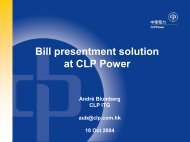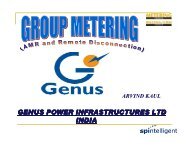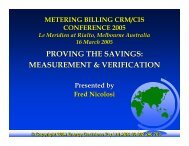GoodCents Select – The 21 Century Residential Energy Management Program
GoodCents Select – The 21 st Century Residential ... - Metering.com
GoodCents Select – The 21 st Century Residential ... - Metering.com
- No tags were found...
You also want an ePaper? Increase the reach of your titles
YUMPU automatically turns print PDFs into web optimized ePapers that Google loves.
Slide 1<br />
<strong>GoodCents</strong> <strong>Select</strong> <strong>–</strong> <strong>The</strong> <strong>21</strong> st <strong>Century</strong><br />
<strong>Residential</strong> <strong>Energy</strong> <strong>Management</strong><br />
<strong>Program</strong><br />
Brian White<br />
Gulf Power Company<br />
Pensacola, Florida<br />
May 2, 2003
Slide 2<br />
<strong>GoodCents</strong> <strong>Select</strong> <strong>–</strong> <strong>Program</strong> Development<br />
<br />
<strong>The</strong> Critical Peak Pricing Notion<br />
<strong>–</strong> Four Interdependent Components<br />
1. A time-varying rate design with a<br />
near real-time pricing component,<br />
2. An in-home, customer-<br />
programmed, automated energy<br />
management (AEM) system,<br />
3. A way to rapidly communicate rate<br />
changes, critical peak conditions,<br />
and other messages to program<br />
participants, and<br />
4. A means of recording and retrieving<br />
the requisite billing determinants.
Slide 3<br />
<strong>GoodCents</strong> ® SELECT<br />
<strong>Residential</strong> Service Variable Pricing (Rate Schedule<br />
RSVP)<br />
•Standard <strong>Residential</strong> Customer Charge applies: $10.00 per month<br />
•RSVP Participation Charge: $4.95 per month<br />
•Prices per kWh (includes energy charge, fuel, ECCR, PPCC, and ECRC)<br />
Low 4.2 cents/kWh<br />
Medium 5.4 cents/kWh<br />
High 10.0 cents/kWh<br />
Critical 30.9 cents/kWh<br />
Standard <strong>Residential</strong> Rate: 6.3 cents/kWh
Slide 4<br />
<strong>GoodCents</strong> <strong>Select</strong> <strong>–</strong> <strong>Program</strong> Development<br />
Metering<br />
Communications<br />
A Rate Design<br />
Customer Control<br />
<strong>–</strong> <strong>The</strong> “full cost” of responding to<br />
price changes is much more<br />
than the price difference.<br />
Customers must act in order to<br />
respond.<br />
<strong>The</strong>se actions require time and<br />
effort.<br />
<strong>–</strong> Lowering the incremental<br />
“cost” of responding should<br />
increase the amount of price<br />
response.<br />
<strong>–</strong> An in-home, customer-<br />
programmed, automated<br />
energy management system<br />
lowers this “cost” that<br />
customers must bear.
Slide 5<br />
<strong>GoodCents</strong> <strong>Select</strong> <strong>–</strong> <strong>Program</strong> Development<br />
<strong>–</strong> Rate changes and critical<br />
supply conditions must<br />
be communicated to<br />
consumers if we expect<br />
them or their systems to<br />
invoke the pre-selected,<br />
pre-programmed<br />
programmed<br />
responses.
Slide 6<br />
<strong>GoodCents</strong> <strong>Select</strong> <strong>–</strong> <strong>Program</strong> Development<br />
<strong>–</strong> Customer’s energy consumption<br />
must be tracked and measured.<br />
<strong>The</strong> meter must know what<br />
price or rate is in force at all<br />
times so that it can accurately<br />
“bucket” the energy used.<br />
A near real-time pricing<br />
component implies that both<br />
the customer’s energy<br />
management system and the<br />
customer’s meter will need to<br />
know about it.
Slide 7<br />
Major Components<br />
SuperStat<br />
Communications Gateway<br />
RSVP Rate
Slide 8<br />
PriceStat for 2003
Slide 9<br />
<strong>GoodCents</strong> <strong>Select</strong><br />
<br />
Gulf Power’s Three Research<br />
Questions<br />
1. Could AEM reduce the need for<br />
generation?<br />
2. Would AEM enable existing capacity to<br />
be better used?<br />
3. Would AEM provide customers with<br />
value?
Slide 10<br />
<strong>GoodCents</strong> ® SELECT<br />
1/4/02 Critical time 9:00 AM to 10:00 AM<br />
kW<br />
6<br />
5<br />
4<br />
3<br />
2<br />
1<br />
0<br />
1 6 11 16 <strong>21</strong><br />
Time<br />
Test Group<br />
Control Group<br />
Preliminary
Slide 11<br />
<strong>GoodCents</strong> ® SELECT<br />
1/8/02 Critical time 6:00 AM to 7:00 AM<br />
kW<br />
6<br />
5<br />
4<br />
3<br />
2<br />
1<br />
0<br />
1 6 11 16 <strong>21</strong><br />
Time<br />
Control Group<br />
Preliminary
Slide 12<br />
<strong>GoodCents</strong> ® SELECT<br />
1/2/02 No Critical<br />
kW<br />
5.0<br />
4.0<br />
3.0<br />
2.0<br />
1.0<br />
0.0<br />
1 5 9 13 17 <strong>21</strong><br />
Time<br />
Preliminary
Slide 13<br />
<strong>GoodCents</strong> ® SELECT<br />
7/17/02 Critical time 4:00 PM to 5:00 PM<br />
5<br />
4<br />
kW<br />
3<br />
2<br />
1<br />
Test Group<br />
Control Group<br />
0<br />
1 6 1 1 16 2 1<br />
Time<br />
Preliminary
Slide 14<br />
<strong>GoodCents</strong> ® SELECT<br />
7/18/02 Critical tim e 2:00 PM to 4:00 PM<br />
6<br />
5<br />
kW<br />
4<br />
3<br />
2<br />
1<br />
Test G roup<br />
C ontrol Group<br />
0<br />
1 6 1 1 1 6 2 1<br />
Time<br />
Preliminary
Slide 15<br />
<strong>GoodCents</strong> ® SELECT<br />
7/16/02 No Critical<br />
kW<br />
5<br />
4.5<br />
4<br />
3.5<br />
3<br />
2.5<br />
2<br />
1.5<br />
1<br />
0.5<br />
0<br />
1 5 9 1 3 1 7 2 1<br />
Time<br />
Preliminary
Slide 16<br />
Price Response results from Gulf Power’s<br />
<strong>Residential</strong> Variable Pricing Rate<br />
Case study of January 24, 2003 peak load day.<br />
Minimum temperature on January 24th was 18 degrees F. Minimum<br />
temperature forecast on Gulf’s winter peak day is 27 degrees F.<br />
Gulf Power called a Critical (sent a Critical Price signal to its Good<br />
Cents <strong>Select</strong> customers) on January 24th between the hours of 7a.m.<br />
and 9a.m.<br />
Number of residences receiving the Critical Price signal on Jan 24<br />
(via RF paging signals) = 2,744<br />
Winter demand reduction per residence at the generator<br />
(accounting for losses) = 3.74kW<br />
Total demand reduction on Jan 24th = 2744 * 3.74 = 10.3mW
Slide 17<br />
Price Response results from Gulf Power’s<br />
<strong>Residential</strong> Variable Pricing Rate<br />
Gulf system Total Territorial Supply (TS) on January 24, 2003 and<br />
price tier in effect:<br />
TS<br />
Price<br />
between 5 a.m. and 6 a.m. 2309 mW medium<br />
between 6 a.m. and 7 a.m. 2500 mW high<br />
between 7 a.m. and 8 a.m. 2497 mW Critical<br />
between 8 a.m. and 9 a.m. 2414 mW Critical<br />
between 9 a.m. and 10 a.m. 2293 mW high<br />
Note two conclusions:<br />
1 st • the peak occurred between 6a.m. and 7a.m. If not for the RSVP rate and Good<br />
Cents <strong>Select</strong>, the peak would have occurred between 7a.m. and 8a.m. That is the peak<br />
hour was shifted.<br />
2 nd • the magnitude of the peak (2500mW) was 7mW less than it otherwise would<br />
have been without the variable pricing rate. That is, in the absence of the RSVP rate<br />
and Good Cents <strong>Select</strong> equipment, the peak would have been 2497mW + 10.3mW =<br />
2507mW.
Slide 18<br />
<strong>GoodCents</strong> <strong>Select</strong> <strong>–</strong> Questions Answered<br />
AEM will provide customers with value.<br />
•Greater Control<br />
•Better Information<br />
•Bill Savings<br />
“A significantly high percentage of<br />
participant customers are very<br />
satisfied. . .”<br />
Value of Saved <strong>Energy</strong> (1,433 kWh) = $100<br />
Rate Savings due to Timing of Consumption = $87<br />
Total Annual Savings = $187<br />
Average Annual Bill w/o AEM = $1254<br />
Average Annual Bill with AEM = $1067<br />
Percentage Bill Savings = 14.9%
Slide 19<br />
<strong>GoodCents</strong> <strong>Select</strong> <strong>–</strong> Questions Answered<br />
AEM provides other benefits too.<br />
<strong>–</strong> Customer Choice Not Utility Control<br />
Enhances Customer Satisfaction<br />
Reduces Policing Requirements vs. Direct Load<br />
Control<br />
Produces Reliable Peak Demand Reductions<br />
<strong>–</strong> Requires No Utility Paid Incentive<br />
Customers Save by Acting and Reacting<br />
Customers Unwilling to Change Will Not Participate<br />
<strong>–</strong> AEM is Equitable<br />
Heaviest Electricity Users are the Target Market<br />
Capacity Savings Benefit All Users<br />
<strong>–</strong> Customers Prefer AEM<br />
Focus Groups Results Prove
Slide 20<br />
<strong>GoodCents</strong> <strong>Select</strong> <strong>–</strong> <strong>Program</strong> Economics<br />
Subscribing customers will pay to<br />
participate!<br />
<strong>–</strong> Customers Choose Responses<br />
Respond Respond to both price & lifestyle<br />
<strong>–</strong> <strong>Program</strong>med Responses - Automatic<br />
<strong>–</strong> Override => Customer Control<br />
<strong>–</strong> Customers connected for value-added<br />
added<br />
services<br />
<strong>–</strong> Bill Savings Potential<br />
Customer-controlled savings
Slide <strong>21</strong><br />
<strong>GoodCents</strong> <strong>Select</strong> <strong>–</strong> <strong>Program</strong> Economics<br />
Significant Real-Time Demand Reduction!<br />
<strong>–</strong> Over 2 kW per subscriber per critical event<br />
<strong>–</strong> ≈ 100 event-hours per year is O.K.<br />
Event Event durations of 1 to 3 hours<br />
<strong>–</strong> <strong>The</strong>se demand responses are exactly like<br />
quickly dispatchable capacity<br />
CTs or Hour-Ahead Spot Market Purchases<br />
80 MW of available critical peak demand response<br />
will displace the need for an 80 MW bank of CTs or<br />
the need for 80 MW of hour ahead capacity<br />
purchases<br />
<strong>–</strong> What is your avoided cost of peaking<br />
capacity?
Slide 22<br />
<strong>GoodCents</strong> <strong>Select</strong> <strong>–</strong> <strong>Program</strong> Economics<br />
Load reshaping can be profit preserving<br />
<strong>–</strong> Moving consumption from higher to<br />
lower priced periods reduces revenues<br />
and reduces costs but profits can be<br />
preserved<br />
<strong>Program</strong> facilitates the promotion of the<br />
most economically efficient electric<br />
end-use loads and technologies<br />
<strong>–</strong> Off peak end-uses of electricity become<br />
relatively more economic <strong>–</strong> sales can<br />
increase
Slide 23<br />
<strong>GoodCents</strong> <strong>Select</strong> <strong>–</strong> <strong>Program</strong> Economics<br />
Utility’s Viewpoint<br />
<strong>–</strong> If the present value of the<br />
subscriber revenue plus the<br />
present value of the avoided<br />
capacity requirements exceed the<br />
present value of all program<br />
costs, the utility should offer the<br />
program.
Slide 24<br />
<strong>GoodCents</strong> <strong>Select</strong> <strong>–</strong> <strong>Program</strong> Economics<br />
Participant’s Viewpoint<br />
<strong>–</strong> If the aggregated benefits a prospective<br />
participant expects to receive from <strong>GoodCents</strong><br />
<strong>Select</strong> exceeds her out-of<br />
of-pocket costs to<br />
participate, she’ll subscribe.<br />
Opportunities for bill savings<br />
Enhanced sense of control over electricity & home<br />
Enhanced sense of contributing to reliable power<br />
supply<br />
Enhanced sense of contributing to a better<br />
environment<br />
<strong>The</strong> net benefits of the available value added services<br />
through <strong>GoodCents</strong> <strong>Select</strong>
Slide 25<br />
<strong>GoodCents</strong> ® SELECT<br />
<strong>The</strong> Primary Motivators
Slide 26<br />
<strong>GoodCents</strong> ® SELECT
Slide 27<br />
<strong>GoodCents</strong> ® SELECT<br />
Questions or Additional Information<br />
Contact:<br />
<br />
Brian White<br />
(850) 444-6438<br />
BLWHITE@southernco.com<br />
Gulf Power<br />
One <strong>Energy</strong> Place<br />
Pensacola, FL 32520-0231












